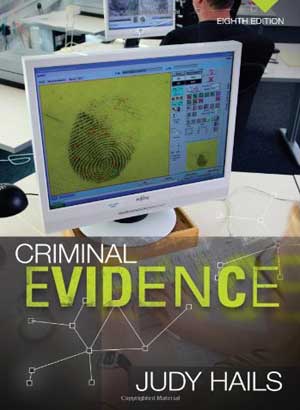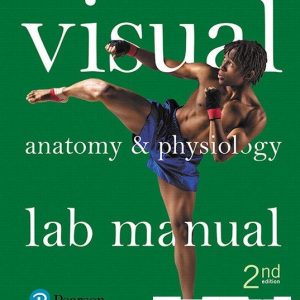This is completed downloadable of Test Bank for Criminal Evidence 8th Edition Hails

Product Details:
- ISBN-10 : 1285062868
- ISBN-13 : 978-1285062860
- Author: Judy Hails
With an emphasis on real-world applications, CRIMINAL EVIDENCE, Eighth Edition, provides readers with comprehensive, up-to-date coverage of common evidentiary topics in a brief, affordable format. This book thoroughly explores constitutional issues essential to the collection and seizure of admissible evidence and legal interrogation, carefully outlining concepts and processes applicable to every state and pointing out where great interstate variation exists or specific state codes may have a strong impact. Current trends and topics discussed include terrorism and homeland security, scientific evidence, Federal Rules of Evidence, hearsay, and the appellate system.
Table of Content:
- Ch 1: Introduction
- Feature Case: Jerry Sandusky
- Learning Objectives
- Key Terms
- What Is Evidence?
- Burden of Proof
- Role of Judge and Jury
- Role of the Prosecutor
- Role of the Defense Attorney
- History and Development of Rules of Evidence
- Sources of Evidence Law
- How Legal Research Is Conducted
- Summary
- Review Questions
- Writing Assignment
- Sources
- Notes
- Ch 2: The Role of the Courts
- Featured Case: The Six Trials of Curtis Flowers
- Learning Objectives
- Key Terms
- Introduction
- Post-Conviction Proceedings
- Summary
- Review Questions
- Writing Assignment
- Sources
- Notes
- Ch 3: The Adjudication Process
- Feature Case: Trial of Dr. Conrad Murray
- Learning Objectives
- Key Terms
- Introduction
- The Criminal Complaint
- Arraignment
- Preliminary Hearing
- Grand Jury
- Suppression Hearing
- Discovery
- Plea Bargaining
- The Trial
- Sentencing
- Post-Conviction Proceedings
- Summary
- Review Questions
- Writing Assignment
- Sources
- Notes
- Ch 4: Types of Evidence
- Feature Case: Casey Anthony
- Learning Objectives
- Key Terms
- Relevant Evidence
- Direct and Circumstantial Evidence
- Testimonial and Real Evidence
- Substitutes for Evidence
- Summary
- Review Questions
- Writing Assignment
- Sources
- Notes
- Ch 5: Direct and Circumstantial Evidence
- Feature Case: The Petit Murders
- Learning Objectives
- Key Terms
- Basic Definitions
- Weight of Evidence
- Circumstantial Evidence of Ability to Commit the Crime
- Circumstantial Evidence of Intent
- Circumstantial Evidence of Guilt
- Character
- Other Acts Evidence
- Offers to Plead Guilty
- Circumstantial Evidence Involving the Victim
- Rape Shield Laws
- Summary
- Review Questions
- Writing Assignment
- Sources
- Notes
- Ch 6: Witnesses
- Feature Case: Roger Clemens’s Perjury Trial
- Learning Objectives
- Key Terms
- Competency of Witness
- Impeachment
- Rehabilitation
- Corroboration
- Memory Failures
- Unavailable Witnesses
- Opinion Rule
- Summary
- Review Questions
- Writing Assignment
- Sources
- Notes
- Ch 7: Crime Scene Evidence and Experiments
- Feature Case: The Grim Sleeper
- Learning Objectives
- Key Terms
- Introduction
- Crime Scene Evidence
- Scientific Evidence
- Commonly Accepted Scientific Tests
- Tests That Are Not Commonly Accepted
- Experiments
- Summary
- Review Questions
- Writing Assignment
- Sources
- Notes
- Ch 8: Documentary Evidence, Models, Maps, and Diagrams
- Feature Case: Bernie Madoff’s Ponzi Scheme
- Learning Objectives
- Key Terms
- Definitions Used to Describe Documents
- Authentication
- Forensics Document Examiners
- Computers and Other Electronic Devices
- Application of the Hearsay Rule to Documents
- Introducing the Contents of Documents
- Photographic Evidence
- Models, Maps, and Diagrams
- Summary
- Review Questions
- Writing Assignment
- Sources
- Notes
- Ch 9: Hearsay and Its Exceptions
- Feature Case: Drew Peterson
- Learning Objectives
- Key Terms
- Basic Hearsay Definitions
- The Hearsay Rule
- Testimonial Hearsay
- Unavailability of the Hearsay Declarant
- Exceptions to the Hearsay Rule
- Admissions and Confessions
- Declarations Against Interest (Declarant Must Be Unavailable)
- Spontaneous Statements (Also Called Excited Utterances)
- Contemporaneous Declaration (Also Called Present Sense Impression)
- Dying Declaration Exception (Also Called Statement Under Belief of Impending Death; Declarant Must B
- Mental or Physical State
- Reputation
- Former Testimony (Witness Must Be Unavailable)
- Prior Inconsistent Statements
- Prior Consistent Statements
- Ancient Documents
- Summary
- Review Questions
- Writing Assignment
- Sources
- Notes
- Ch 10: Privileged Communications
- Feature Case: James Holmes’s Notebook
- Learning Objectives
- Key Terms
- Basis for Privileges
- Attorney–Client Privilege
- Husband–Wife Privilege
- Physician–Patient Privilege
- Clergy–Penitent Privilege
- Media Reporter Privilege
- Executive Privilege
- Privilege for Official Information
- Summary
- Review Questions
- Writing Assignment
- Sources
- Notes
- Ch 11: Developing Law of Search and Seizure
- Feature Case: Search of Lois Goodman’s Home
- Learning Objectives
- Key Terms
- History and Development of Fourth Amendment
- Definitions
- Warrant Requirements
- Exclusionary Rule
- Summary
- Review Questions
- Writing Assignment
- Sources
- Notes
- Ch 12: Field Interviews, Arrests, and Jail Searches
- Feature Case: Arrest of George Zimmerman
- Learning Objectives
- Key Terms
- Right to Use Force to Detain or Arrest Suspects or Obtain Evidence
- Field Interviews
- Arrests
- Booking
- Jail and Prison Searches
- Summary
- Review Questions
- Writing Assignment
- Sources
- Notes
- Ch 13: Plain View, Consent, Vehicle, and Administrative Searches
- Feature Case: Searches of Mikel Leshoure’s Cars
- Learning Objectives
- Key Terms
- Plain View and Open Fields Doctrines
- Abandoned Property
- Consent Searches
- Vehicle Searches
- Administrative Searches
- Summary
- Review Questions
- Writing Assignment
- Sources
- Notes
- Ch 14: USA PATRIOT Act, Foreign Intelligence, and Other Types of Electronic Surveillance Covered by
- Feature Case: Rublowitz Family Drug Business
- Learning Objectives
- Key Terms
- Eavesdropping and the Misplaced Reliance Doctrine
- Electronic Surveillance and Wiretap Act of 1968
- Federal Legislation on Electronic Surveillance
- Foreign Intelligence Surveillance Act of 1978 (FISA)
- National Security Letters
- Summary
- Review Questions
- Writing Assignment
- Sources
- Notes
- Ch 15: Self-Incrimination
- Feature Case: Confessions by Cristian Fernandez
- Learning Objectives
- Key Terms
- Scope of the Privilege Against Self-Incrimination
- Miranda Warnings
- Sequential Interrogations
- Special Situations
- Post-Arraignment Confessions
- Summary
- Review Questions
- Writing Assignment
- Sources
- Notes
- Ch 16: Identification Procedures
- Feature Case: Exoneration of James Curtis Williams and Raymond Jackson
- Learning Objectives
- Key Terms
- Definitions Used for Identification Procedures
- Fourth Amendment Rights During Identification Procedures
- Fifth Amendment Rights During Identification Procedures
- Sixth Amendment Rights During Identification Procedures
- Due Process Rights During Identification Procedures
- Use of Identification Testimony at Trial
- Summary
- Review Questions
- Writing Assignment
- Sources
- Notes
- Ch 17: Preparing the Case for Court
- Feature Case: Material Witness Arrested and Held Without Bail
- Learning Objectives
- Key Terms
- Introduction
- Reviewing Facts of the Case
- Working With the Prosecutor
- Dress and Demeanor
- Contacts With Lawyers, Witnesses, and Jurors
- Press Coverage
- Summary
- Review Questions
- Writing Assignment
- Sources
- Notes
- Appendices
- Glossary
- Index





